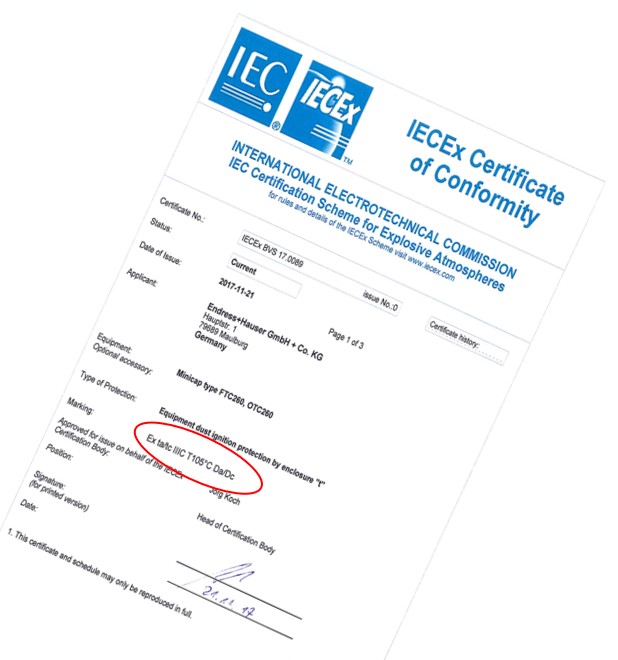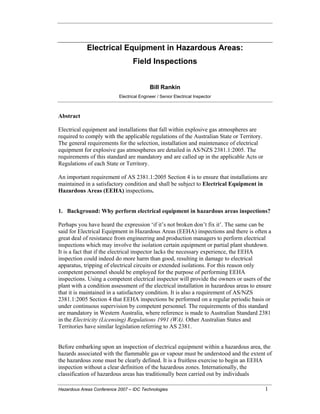How Roar Solutions can Save You Time, Stress, and Money.
How Roar Solutions can Save You Time, Stress, and Money.
Blog Article
The Greatest Guide To Roar Solutions
Table of ContentsIndicators on Roar Solutions You Should KnowNot known Incorrect Statements About Roar Solutions 3 Simple Techniques For Roar Solutions
In such an ambience a fire or surge is feasible when 3 standard problems are satisfied. This is frequently referred to as the "harmful location" or "burning" triangle. In order to shield installments from a possible explosion an approach of evaluating and categorizing a possibly dangerous location is required. The function of this is to make certain the correct option and setup of tools to eventually protect against an explosion and to guarantee security of life.
(https://www.40billion.com/profile/91601565)
No equipment needs to be set up where the surface temperature of the equipment is higher than the ignition temperature of the offered hazard. Below are some common dust harmful and their minimum ignition temperature. Coal Dust 380C 225C Polythene 420C (thaws) Methyl Cellulose 420C 320C Starch 460C 435C Flour 490C 340C Sugar 490C 460C Grain Dirt 510C 300C Phenolic Resin 530C > 450C Aluminium 590C > 450C PVC 700C > 450C Soot 810C 570C The chance of the danger existing in a concentration high adequate to cause an ignition will differ from place to location.
In order to classify this danger an installation is separated right into locations of risk relying on the amount of time the hazardous exists. These locations are described as Areas. For gases and vapours and dirts and fibres there are 3 zones. Zone 0 Zone 20 A dangerous atmosphere is extremely likely to be existing and might exist for long durations of time (> 1000 hours annually) and even continually Area 1 Zone 21 A hazardous atmosphere is feasible however unlikely to be existing for long durations of time (> 10 450 C [842 F] A category of T6 indicates the minimal ignition temperature level is > 85 C [185 F] Harmful area electric devices maybe created for use in greater ambient temperatures. This would certainly indicated on the rating plate e.g. EExe II C T3 Ta + 60C( This implies at 60C ambient T3 will not be exceeded) T1 T1, T2, T3, T4, T5, T6 T2 T2, T3, T4, T5, T6 T3 T3, T4, T5, T6 T4 T4, T5, T6 T5 T5, T6 T6 T6 A T Course rating of T1 indicates the maximum surface area temperature created by the instrument at 40 C is 450 C. Thinking the connected T Course and Temperature score for the equipment are ideal for the area, you can constantly utilize an instrument with a much more stringent Division ranking than required for the location. There isn't a clear response to this concern unfortunately. It really does rely on the kind of devices and what repairs require to be executed. Equipment with certain test procedures that can't be executed in the field in order to achieve/maintain third event rating. Need to come back to the factory if it is before the equipment's solution. Field Repair Work By Authorised Personnel: Difficult testing might not be needed nevertheless specific treatments may require to be followed in order for the equipment to preserve its 3rd party ranking. Authorised employees have to be employed to perform the work properly Repair service have to be a like for like replacement. New component must be thought about as a straight substitute calling for no unique screening of the tools after the repair work is total. Each item of tools with a dangerous score must be reviewed independently. These are detailed at a high level below, but also for even more detailed information, please refer directly to the guidelines.
Not known Details About Roar Solutions
The devices register is a detailed database of devices documents that consists of a minimum set of areas to identify each item's place, technical specifications, Ex category, age, and ecological information. The ratio of Comprehensive to Close inspections will certainly be established by the Devices Danger, which is assessed based on ignition danger (the possibility of a resource of ignition versus the likelihood of a flammable ambience )and the harmful area category
( Zone 0, 1, or 2). Carrying out a robust Risk-Based Assessment( RBI )technique is essential for guaranteeing conformity and security in taking care of Electrical Tools in Hazardous Areas( EEHA).
The 5-Second Trick For Roar Solutions

In terms of eruptive threat, an unsafe area is an environment in which an eruptive environment is present (or might be expected to be existing) in quantities that require unique safety measures for the construction, installment and use equipment. hazardous area course. In this post we explore the obstacles dealt with in the work environment, the threat control procedures, and the required proficiencies to function securely
These materials can, in certain conditions, develop eruptive ambiences and these can have significant and terrible repercussions. Many of us are familiar with the fire triangular remove any type of one of the 3 components and the fire can not occur, but what does this mean in the context of dangerous areas?
In a lot of circumstances, we can do little concerning the degrees of oxygen airborne, yet we can have significant influence on sources of ignition, for instance electrical devices. Unsafe locations are documented on the hazardous area classification drawing and are recognized on-site by the triangular "EX" indication. Right here, amongst other vital info, zones are split into 3 kinds depending on the threat, the likelihood and period that an eruptive ambience will exist; Zone 0 or 20 is deemed one of the most unsafe and Area 2 or 22 is considered the least.
Report this page